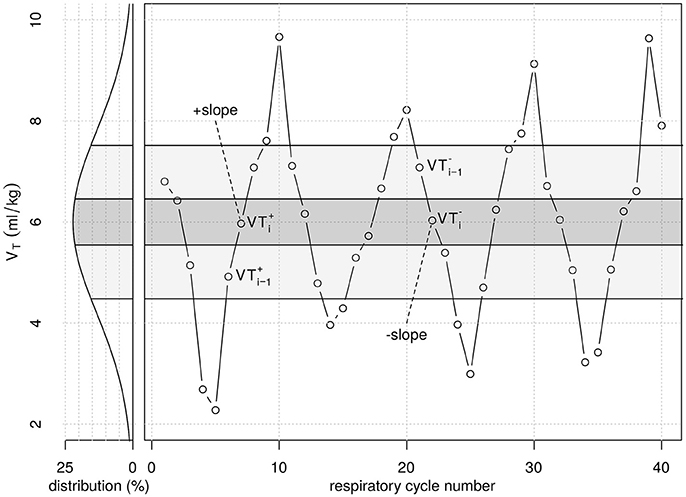
Measurements of heat production (i.e., direct calorimetry) provide a reliable method to quantify metabolic rate however, direct calorimetry requires a considerable amount of space and time commitment and is typically reserved for research purposes. Metabolic rate is directly related to body mass and surface area in humans.

* In patients with neuromuscular disorders or cerebral disorders, a V T of as high as 15 mL/kg might be required, but P plateau should still be kept below 30 cm H 2O. Set inspiratory percentage to achieve an inspiratory/expiratory (I/E) ratio of greater than or equal to 1 : 2. Set pressure to achieve V T as described for VC-CMV. To provide ventilatory support, set pressure to achieve a target V T as described for volume-controlled ventilation. To overcome system resistance in the spontaneous mode (PSV or continuous positive airway pressure ) or in the IMV/SIMV mode, set pressure at peak inspiratory pressure (PIP) − pressure plateau (P plateau) where P plateau is measured in a volume breath or at approximately 5 to 10 cm H 2O. As the patient’s metabolic rate increases, ventilation must change to meet the need for increased oxygen uptake and CO 2 removal ( Box 6-1). A typical healthy person at rest has a total oxygen consumption ( ) of about 250 mL/min and a carbon dioxide production ( ) of about 200 mL/min. The primary goal of volume-controlled continuous mandatory ventilation (VC-CMV) is to achieve a that matches the patient’s metabolic needs. Initial Settings During Volume-Controlled Ventilation The following discussion begins with the basics:, V T, and f.
#ADULT TIDAL VOLUME CHART HOW TO#
Then, regardless of the ventilator involved, they will possess enough information to make an informed decision about how to proceed. It is important for clinicians charged with the responsibility of instituting mechanical ventilation to have a fundamental understanding of the various control variables available on current intensive care unit (ICU) ventilators. Some ventilator manufacturers provide time cycling and have controls for inspiratory time percentage, and still others control total cycle time (TCT). For example, many have V T and rate settings, such as the Puritan Bennett 840 (Covidien-Nellcor and Puritan Bennett, Boulder, Colo.), whereas other ventilators, such as the Servo i (Maquet Inc, Wayne N.J.), allow the operator to set and f. The design characteristics of mechanical ventilator control panels can vary. Initiating volume-control ventilation for a patient requires an understanding of the interaction of several key variables, including settings (V T and f), inspiratory gas flow, flow waveform, inspiratory to expiratory (I : E) ratio, pressure limit, inflation hold (inspiratory pause), and inspiratory pressure and positive end-expiratory pressure (PEEP). This chapter examines how and related variables are set during the initiation of volume ventilation and then focuses on the settings required to initiate pressure ventilation.ĭetermining Initial Ventilator Settings During Volume-Controlled Ventilation 1 This goal can be accomplished by setting an appropriate tidal volume (V T) and respiratory rate or frequency (f) to achieve a desired minute ventilation ( ). The most common reason for instituting mechanical ventilation is to treat respiratory distress in patients who are unable to achieve effective gas exchange.

2 Determine volume loss caused by tubing compliance.ģ Calculate minute ventilation given a patient’s respiratory rate and tidal volume.Ĥ Calculate total cycle time, inspiratory time, expiratory time, flow in L/s, and inspiratory-to-expiratory ratios given the necessary patient data.ĥ Select an appropriate flow rate and pattern.Ħ Calculate initial minute ventilation, tidal volume, and rate for a patient placed on VC-CMV based on the patient’s sex, height, and ideal body weight.ħ Identify the source of the problem when an inspiratory pause cannot be measured.Ĩ Choose an appropriate initial mode of mechanical ventilation, and determine, tidal volume, respiratory frequency, and positive end-expiratory pressure settings based on the patient’s lung pathology, body temperature, metabolic rate, altitude, and acid-base balance.ĩ Evaluate the response in peak inspiratory pressure and plateau pressure when the flow waveform is changed.ġ0 Recommend the selection and initial settings for the various modes of pressure ventilation, including bilevel positive airway pressure, pressure support ventilation, pressure control ventilation, and Servo-controlled (dual modes) ventilation.ġ1 Identify a problem in pressure support ventilation from a pressure-time graph.ġ2 Measure plateau pressure using pressure-time and flow-time waveforms during pressure-controlled mechanical ventilation.ġ3 List the possible causes for a change in pressure during pressure-regulated volume control.ġ4 Identify the mode of ventilation based on the trigger, target, and cycle criteria.


 0 kommentar(er)
0 kommentar(er)
